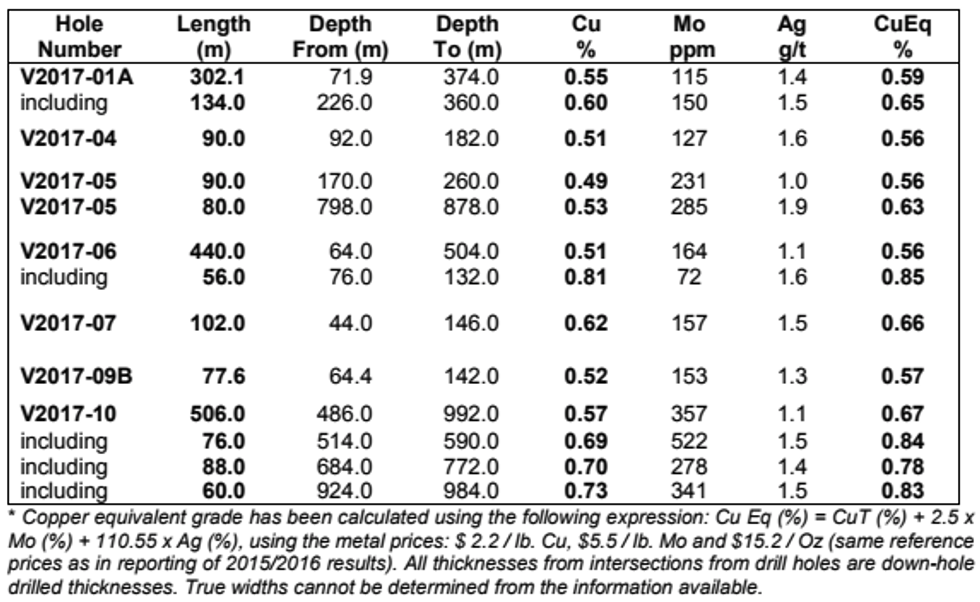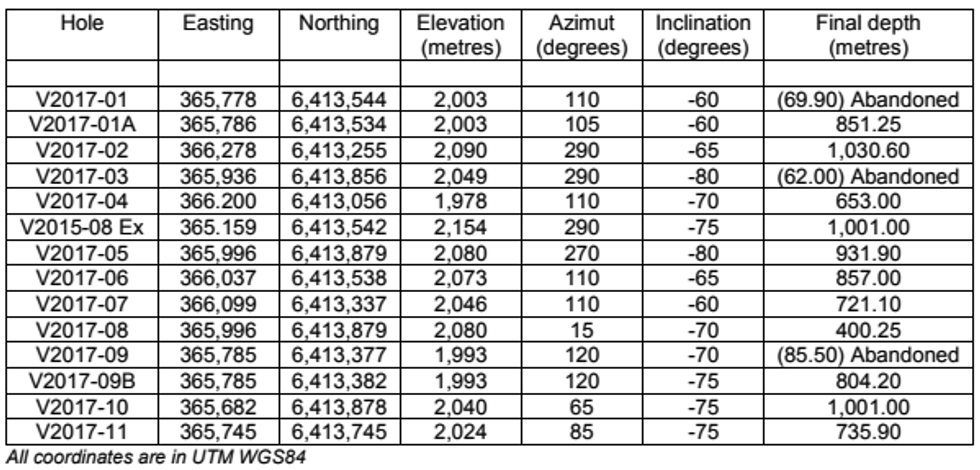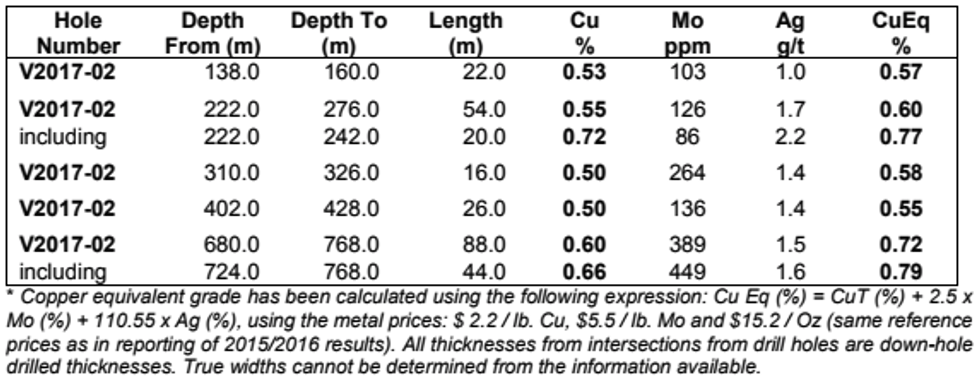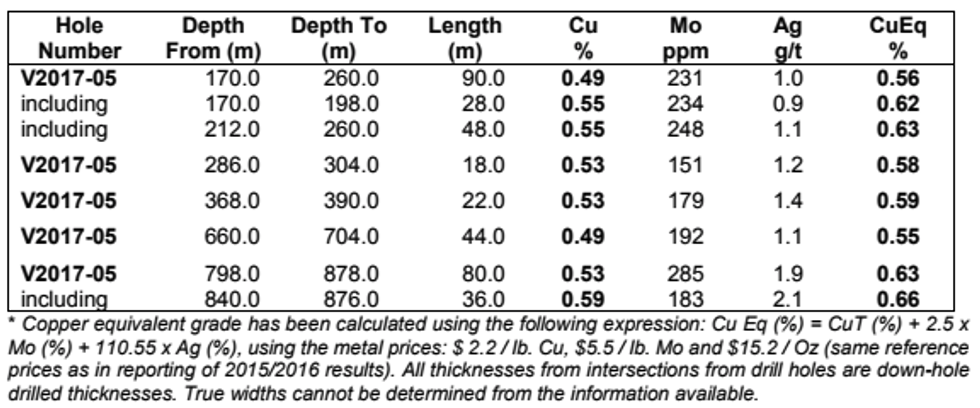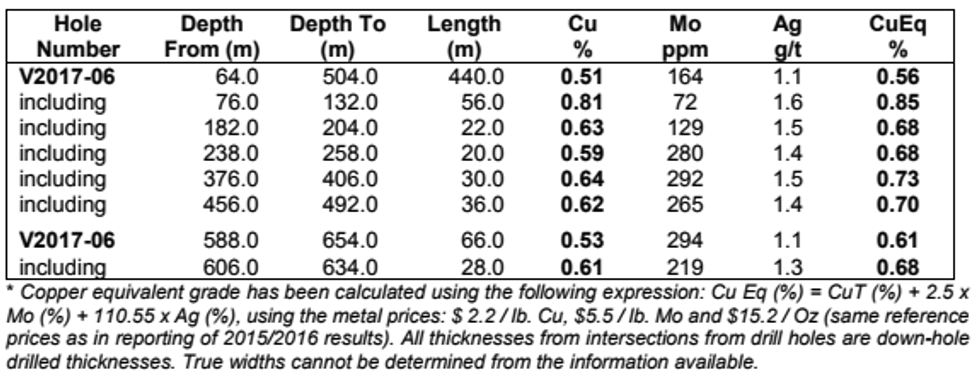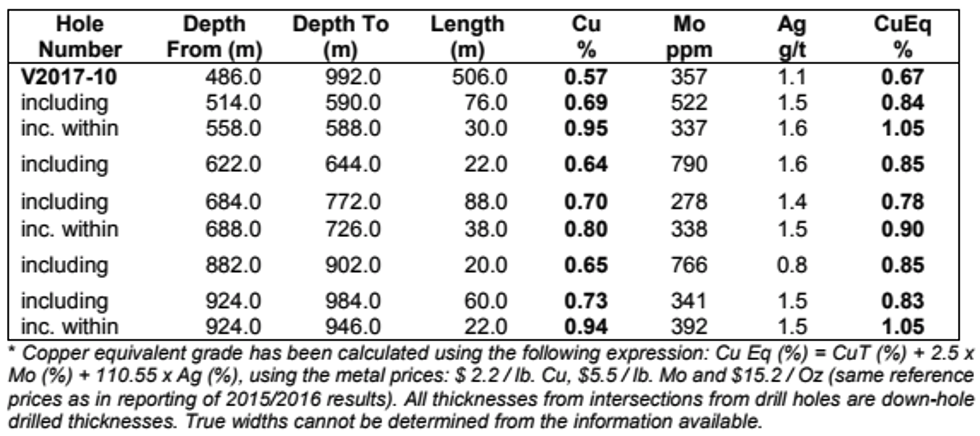Los Andes Presents Consolidated Results of 2017 Drill Program at the Vizcachitas Deposit
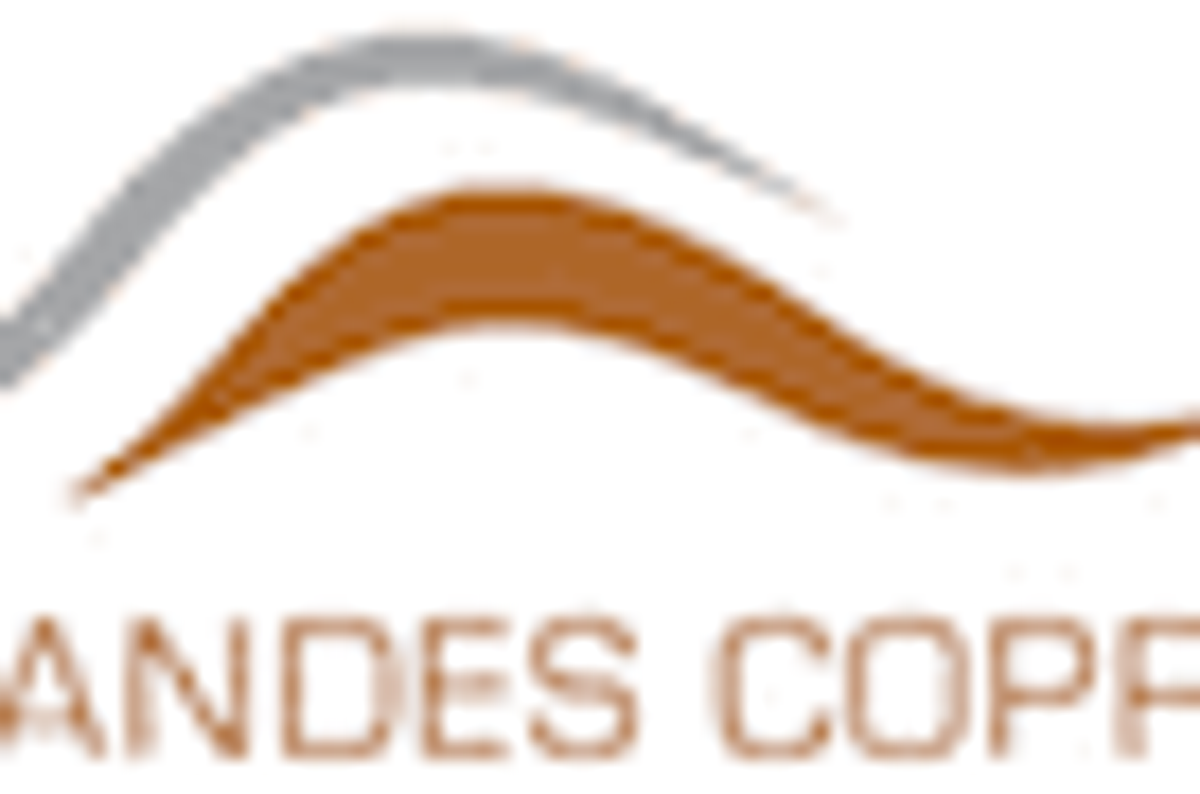
Los Andes Copper (TSXV:LA) is very pleased to present the consolidated results for the 2017 campaign.
RESULTS SUPPORT THE CONTINUITY OF GOOD NEAR-SURFACE MINERALISATION IN THE CENTRAL CORE AND SUPPORT EXTENSION OF HIGHER GRADES TO THE NORTH OF CURRENT CENTRAL CORE
Los Andes Copper (TSXV:LA) is very pleased to present the consolidated results for the 2017 campaign. These results further support the new geological model, with significant intersections in the early diorite porphyry and hydrothermal breccias. The drilling also extends the mineralisation to the north of the central core, and shows continuity of higher grade supergene mineralisation.
Some of the key intervals from this campaign are:
The 2017 drill campaign has:
- Continued to validate the new geological model
- Confirming the importance of the early diorite porphyry and hydrothermal breccias in controlling the higher grade mineralisation of the deposit.
- Confirmed near surface higher grade supergene enriched mineralisation
- Area of 400 by 400 metres where all the drill holes have average supergene grades of greater than 0.5% Cu.
- Includes the following drill holes from the 2015/2017 drill campaigns:
- V2015-03 – 17.9 m @ 0.78% Cu from 44.1 m down-hole
- V2015-05 – 78 m @ 0.56% Cu from 68 m down-hole
- V2015-08 – 92 m @ 0.71% Cu from 92 m down-hole
- V2017-06 – 92 m @ 0.66% Cu from 46 m down-hole
- V2017-07 – 98 m @ 0.61% Cu from 44 m down-hole
- V2017-09B – 77 m @ 0.52% Cu from 64.4 m down-hole
- Demonstrated that the early diorite porphyry and hydrothermal breccias extend a further 250 metres to the north, than previously shown.
- In the northern part of the project, which was previously classified as barren, incudes the following drill holes:
- V2017-10 – 506 m @ 0.57 % Cu from 486 m down-hole,
- V2017-05 – 90 m @ 0.49 % Cu from 170 m down-hole,
- Historical drill hole V-39 – 40.5 m @ 0.55 % Cu from a down-hole depth of 399 m to the end of the drill hole)
- Showed high grade mineralisation over a vertical distance of 825 meters, within the early diorite porphyry and hydrothermal breccias.
- This mineralisation remains open to the north.
- In the northern part of the project, which was previously classified as barren, incudes the following drill holes:
- Extended the high grade primary mineralisation identified during the 2015/2016 drilling campaign
- The drill hole V2015-05 intersected 52 m @ 0.81 % Cu from a down-hole depth of 544 m. The drill hole V2017-02 was drilled underneath V2015-05 and intersected 88 m @ 0.60 % Cu from a down-hole depth of 680 m. This demonstrated the vertical continuity of this well mineralised primary mineralisation over 250 metres vertically.
- The drill hole V2015-08 intersected 502 m @ 0.63 % Cu from a downhole depth of 130 m showing high grade continuity from near surface to depth.
Cautionary Statement: All thicknesses from intersections from drill holes are down-hole drilled thicknesses. True widths cannot be determined from the information available.
Background
Historical drilling was carried out on the Vizcachitas project in three exploration campaigns during 1993, 1996/1997 and 2007/2008. However, the higher grade central core had only been drilled in the 1990’s campaigns and with generally shallower drill holes, therefore not properly reflecting the potential of this core area.
During 2014, a complete review of the historical information was performed to better understand the project, including re-logging all of the 146 drill holes located within the property. The re-logging was led by Gonzalo Saldias, a Chilean geologist and one of the most recognized experts in Chilean porphyry systems. This detailed review showed that the historical logging and geological model had not properly identified the importance of the higher grade early diorite porphyry and hydrothermal breccias. The re-logging showed that these higher grade geological units extend over a distance of 1,400 metres north-south and 700 metres east-west. The mapping showed that these breccias have grades increasing with depth and demonstrates the potential for higher grades below the historical drilling.
In 2015, Los Andes began a drill program to support a new geological model and to demonstrate the extent of the central core mineralisation. A first stage of this exploration campaign was completed in 2015/2016, with eight diamond drill holes totaling 3,610 metres. During 2017, Los Andes carried out a second stage of this campaign with eleven drill holes totaling 8,262 metres.
Location of Drill Holes:
A drill hole location plan and representative sections are available on our website: www.losandescopper.com
Summary of Drill Holes
Drill Hole V2017-01A
This hole was drilled on the south-western part of the central core with a south-eastern direction. The drill hole is 150 metres north of the drill holes V2015-03 and V2015-05. The drill hole is also 100 metres south of the drill hole V2015-08.
The top of bedrock was intersected at 71.9 metres in diorite porphyry with disseminated chalcopyrite, which continued to a depth of 238 metres. Within this sequence, there is secondary enrichment from 134 to 162 metres where the average grade is 0.61 % Cu, 42 ppm Mo and 1.6 g/t Ag. At a depth of 238 metres, the rock type changes to medium grained diorite and continues to a depth of 513.15 metres. Within this sequence, there is a well mineralised interval running from 226 to 360 metres with 0.60 % Cu, 150 ppm and 1.5 g/t Ag. From a depth of 513.15 metres to the end (at depth of 851.25 metres), the hole is primarily in igneous breccias and hydrothermal breccias.
Key intersections from drill hole V2017-01A:
Drill Hole V2017-02
Drill hole V2017-02 is located on the same section as drill hole V2015-05 and V2015-03, and is 100 metres to the south of section for V2017-01A. The hole was drilled in a north-western direction at an inclination of -65 degrees so that it is approximately 200 metres below drill hole V2015-05 on the section. The hole was drilled to test the vertical extent of the mineralisation identified in V2015-05 and the north-south strike length of the early diorite porphyry intersected in V2015-08.
The top of bedrock was intersected at a depth of 63 metres in a hydrothermal breccia with a high pyrite to chalcopyrite ratio. At a depth of 138 metres, there is a well mineralised andesite with 22 m @ 0.53 % Cu, 103 ppm Mo and 1.0 g/t Ag (0.57 % CuEq).
From depth of 205 metres, there is a long sequence of andesites and hydrothermal breccias down to a depth of 428 metres. This interval demonstrates the vertical extent of a similar sequence of rock types intersected in the drill hole V2015-05.
At a depth of 683 metres, the hole intersected the early diorite porphyry as proposed by the new geological model. Assays for this interval indicate 88 m @ 0.60 % Cu, 389 ppm Mo, 1.5 g/t Ag (0.72 % CuEq).
The drill hole then continued in a sequence of later stage tonalities, granodiorites and diorites to a final depth of 1030.6 metres.
Key intersections from drill hole V2017-02:
Drill Hole V2017-04
This hole was drilled 200 metres to the south of drill hole V2017-02 in a south-eastern direction. The hole was planned to test the vertical extension of the hydrothermal breccias identified in the drill holes to the east. The top of bed rock was intersected at a depth of 77 metres. There is a sequence of andesites with hydrothermal and igneous breccias down to a depth of 329 metres. From a down-hole depth of 92 metres, the hole intersected 90 m @ 0.51 % Cu, 127 ppm Mo and 1.6 g/t Ag (0.56 % CuEq) and from a down-hole depth of 142 metres, the drill hole intersected 30 m @ 0.60 % Cu, 121 ppm Mo and 1.8 g/t Ag (0.65 % CuEq).
From a depth of 329 metres, this hole intersected a long sequence of intermineral lower grade granodiorite until the end of the hole at a depth of 653 metres. The hole did not intersect the andesite host rock as expected, demonstrating that the intrusive system is open to the east at this point.
Key intersections from drill hole V2017-04:
Drill Hole V2015-08Ex
The hole V2015-08 was drilled to a depth of 725.5 metres during the 2015/2016 drill campaign but was stopped at this depth due to budget restrictions. The casing was left in the hole so during this campaign we were able to re-enter the hole and extend it. The hydrothermal breccia that was intersected in 2016 at a depth of 712 metres continues through to a depth of 745 metres. From a depth of 745 metres to the end of the drill hole at a depth of 1,001 metres, the drill hole intersected a long sequence of the target early diorite porphyry. This included, from a down-hole depth of 804 metres, 26 m @ 0.50 % Cu, 441 ppm Mo and 1.1 g/t Ag (0.62 % CuEq) and, from a down-hole depth of 946 metres, 28 m @ 0.53 % Cu, 361 ppm Mo and 1.0 g/t Ag (0.64 % CuEq).
Key intersections from drill hole V2015-08Ex:
Drill Hole V2017-05
The hole V2017-05 was drilled in the northern part of the project in a westerly direction. The aim of the hole was to drill from the unmineralised diatreme out towards the early diorite porphyry that had been intersected in drill hole V-39 back in the 1990s. The re-interpretation of the drill hole V-39 with the well mineralised intersection of the early diorite porphyry was key to identifying the extension to the north of higher grade mineralization.
From a depth of 60 metres, there is a sequence of unmineralised diatreme and post mineral dacite dykes to a down-hole depth of 169 metres. From a down-hole depth of 170 metres, the drill hole intersected the early diorite porphyry with 28 me @ 0.55 % Cu, 234 ppm Mo and 0.9 g/t Ag (0.62 % CuEq).
From a depth of 198 metres, a sequence of early diorite porphyry, fine diorite and medium grain diorites extends to a downhole depth of 377 metres. Within this sequence, the hole intersected 48 m @ 0.55 % Cu, 248 ppm Mo and 1.1 g/t Ag (0.63 % CuEq) from a down-hole depth of 212 m and 18 m @ 0.53 % Cu, 151 ppm Mo and 1.2 g/t Ag (0.58 % CuEq) from a downhole depth of 286 m.
From a depth of 377 metres to depth of 658 metres, the drill hole intersected a hydrothermal breccia and then, from 658 metres to 904 metres, the hole intersected medium grained dirorites and igneous breccias. From 904 metres to the end of the hole at 931.9 metres, there is an intermineral tonalite intrusive. This sequence includes 80 m @ 0.53 % Cu, 285 ppm Mo and 1.9 g/t Ag (0.63 % CuEq) from a down-hole depth of 798 m.
Key intersections from drill hole V2017-05:
Drill Hole V2017-06
This hole was drilled in a south-easterly direction underneath V2015‑08 which was drilled in a north-easterly direction. The aim of this hole was to confirm the good mineralisation identified in V2015-08, and then to test the eastward extension of this mineralisation.
The top of bedrock was intersected at a depth of 15 metres. There is a sequence of andesite and hydrothermal breccias to a depth of 802 metres. From a down-hole depth of 64 metres, there are 440 m @ 0.51 % Cu, 164 ppm Mo and 1.1 g/t Ag (0.56 % CuEq) in andesites. This interval includes 56 m @ 0.81 % Cu, 72 ppm Mo and 1.6 g/t Ag (0.85 % CuEq) from a down-hole depth of 76m. At a depth of 802 metres, the hole intersected an intermineral tonalite intrusive. The hole was stopped at a depth of 857 metres.
Key intersections from drill hole V2017-06:
Drill Hole V2017-07
This hole was drilled in a south-easterly direction underneath drill holes V2015 05 and V2017-02, which were drilled in a north-easterly direction. The aim of this drill hole was to confirm the good mineralisation identified in these other holes and then to test the eastward extension of this mineralisation.
The top of bedrock was intersected at a depth of 33 metre and the hole continued through andesite and hydrothermal breccias to final depth of 721 metres. From a down-hole depth of 44 metres, the drill hole intersected 102 m @ 0.62 % Cu, 157 ppm Mo and 1.5 g/t Ag (0.66 % CuEq) in andesites. Mineralisation continues to a down-hole depth of 344 metres averaging 0.48 % Cu, 135 ppm Mo and 1.2 g/t Ag (0.53 % CuEq) over 300 m. The mineralisation below this depth decreases as the drill hole intersected andesites and a post mineral dacite dyke.
Key intersections from drill hole V2017-07:
Drill Hole V2017-08
This hole was drilled in a northerly direction from the same platform as V2017‑05. The aim of the hole was to test the covered area between the two outcropping un-mineralised diatreme breccias. The hole was speculative in that there are no nearby drill holes and no outcrop. If the drill hole had showed that there was mineralised material between these two outcrops, this would have opened up a large area to the west. In the end, the hole encountered only diatreme indicating that the two outcrops are connected at depth.
Drill Hole V2017-09B
This hole was drilled in a south-east direction from the same platform as the drill hole V2015-02. The hole was designed to test the southern extension of the mineralisation identified in V2015-03 and V2015-05. The top of bedrock was intersected at a depth of 64.4 metres, where a sequence of andesites and hornfels continued to a depth of 570.9 metres. The drill hole then entered a tonalite until the end at a down-hole depth of 804.2 metres. From the top of bedrock, there are 77.6 m @ 0.52 % Cu, 153 ppm Mo and 1.3 g/t Ag (0.57 % CuEq) from a down-hole depth of 64.4 m.
Key intersections from drill hole V2017-09B:
Drill Hole V2017-10
This hole was drilled in a north-east direction to check the northern extension of the mineralisation that had been identified in V2017-05. The top of bedrock was intersected at a depth of 50.5 metres. The hole cut a sequence of fine and medium grained diorites and occasional hydrothermal breccias to a depth of 486 metres.
From a depth of 486 metres, the hole entered a long sequence of hydrothermal breccias, with 506 m @ 0.57 % Cu, 357 ppm Mo and 1.1 g/t Ag (0.67 % CuEq). Within this run there are some higher grade sections with 30 m @ 0.95 % Cu, 337 ppm Mo and 1.6 g/t Ag (1.05 % CuEq) from 558 m down-hole and 88 m @ 0.70 % Cu, 278 ppm Mo and 1.4 g/t Ag (0.78 % CuEq) from 684 m down-hole.
Grades improve with depth as the chalcopyrite-pyrite ratio increases and, from a depth of 920 metres, bornite was identified in hole with up to 20 percent of the sulphides being bornite. This mineralisation shows the potential for the grade to increase with depth.
Key intersections from drill hole V2017-10:
Drill Hole V2017-11
This hole was drilled 150 metres to the south of V2017-10, to find the southern extension of the mineralisation identified in drill holes V2017-05 and V2017-10. This hole was also intended to check the northern extensions of the mineralisation identified in V2015-01 and V2015-08. The top of bedrock was intersected at a depth of 86 metres in a fine grained diorite which continued to a depth of 632 metres.
Within this run, there are some higher grade sections with 26 m @ 0.55 % Cu, 253 ppm Mo and 1.2 g/t Ag (0.63 % CuEq) from 488 m down-hole. From a depth of 600 metres, bornite mineralisation was identified with up to 10 percent of the sulphides being bornite. The bornite mineralisation, as in hole V2017-10, demonstrates the potential for increasing grades with depth. From a depth of 632 metres, the drill hole entered a post mineral dacite dyke and diatreme.
Key intersections from drill hole V2017-11:
QA/QC
Quality assurance and quality control procedures include the systematic insertion of duplicate and standard samples in to the sample stream. Drill core samples were sawn in half, labelled, placed in sealed bags and were shipped directly to the preparatory laboratory of ALS Minerals in Coquimbo, Chile. All geochemical analyses were performed by ALS Minerals in Lima Peru. All samples were assayed using the method ME-MS61, a four-acid digestion with an ICP-MS finish. Copper samples with grades above 0.6 % Cu were reanalysed using ALS method Cu-OG62, a four-acid digestion with an AAS finish.
Mr. Amberg MSc CGeol FGS is the Qualified Person responsible for the preparation of this news release.
Team Credentials
Mr. Amberg MSc CGeol FGS is a geologist who is a graduate of the Royal School of Mines, London, has an MSc. from University College and is also a Chartered Geologist with the Geological Society of London. He has close to 30 years of diverse experience having worked in Asia, Africa and South America for both multinational and junior companies. He began his career in 1986 working with Anglo American in South Africa before moving on to an exploration position with Severin-Southern Sphere. In 1990 Mr. Amberg moved to Chile where he first worked with Bema Gold on the Refugio project before taking up a position with Rio Tinto. At Rio Tinto he was involved in exploration programs in the Atacama and Magallanes Regions and managed the Barreal Seco (now part of Las Cenizas) exploration program. In 1996 he joined Kazakhstan Minerals Corporation in Kazakhstan, setting up and managing offices for the drilling and resource estimation for JORC compliant feasibility studies on three large projects that are now operating mines. He became General Director for two joint ventures in KazMinCo where he managed all technical and local issues. In 2001 he returned to Chile where he started a geological consulting firm specialising in project evaluation and NI 43-101 technical reports. Mr. Amberg’s clients included Rio Tinto, Barrick, Codelco, Anglo American, Pan Pacific Copper and various junior mining companies. He joined Los Andes Copper in 2012 as Chief Geologist and is now also the President and Chief Executive Officer.
Mr. Amberg MSc CGeol FGS is a Qualified Person under NI 43-101.
Gonzalo Saldias is a geologist who is a graduate of Universidad Católica del Norte, Chile. He has over 35 years of experience working within Chile and internationally; mainly on copper porphyry, epithermal gold silver and iron-oxide copper gold systems. For the last seven years, he worked for Antofagasta Minerals evaluating copper porphyry projects within Chile, assessing their geological and economical potential. Prior to that he had worked for ten years with Placer Dome Latin America, generating and evaluating exploration projects within the region. Prior to Placer Dome, he worked for Codelco as head of exploration geology for the El Salvador Division, developing the prospective areas near to the mine. He also worked for Northern Resources, Homestake, Utah, Anaconda and as an independent consultant.
For more information please contact:
Antony J. Amberg, President & CEO Tel: +56 2 2954-0450
Aurora Davidson, CFO Tel: 604-697-6207
E-Mail: info@losandescopper.com or visit our website at: www.losandescopper.com
Certain of the information and statements contained herein that are not historical facts, constitute “forward-looking information” within the meaning of the Securities Act (British Columbia), Securities Act (Ontario) and the Securities Act (Alberta) (“Forward-Looking Information”). Forward-Looking Information is often, but not always, identified by the use of words such as “seek”, “anticipate”, “believe”, “plan”, “estimate”, “expect” and “intend”; statements that an event or result is “due” on or “may”, “will”, “should”, “could”, or might” occur or be achieved; and, other similar expressions. More specifically, Forward-Looking Information involves known and unknown risks, uncertainties and other factors which may cause the actual results, performance or achievements of the Company, or industry results, to be materially different from any future results, performance or achievements expressed or implied by such Forward-Looking Information; including, without limitation, the achievement and maintenance of planned production rates, the evolving legal and political policies of Chile, the volatility in the Chilean economy, military unrest or terrorist actions, metal and energy price fluctuations, favourable governmental relations, the availability of financing for activities when required and on acceptable terms, the estimation of mineral resources and reserves, current and future environmental and regulatory requirements, the availability and timely receipt of permits, approvals and licenses, industrial or environmental accidents, equipment breakdowns, availability of and competition for future acquisition opportunities, availability and cost of insurance, labour disputes, land claims, the inherent uncertainty of production and cost estimates, currency fluctuations, expectations and beliefs of management and other risks and uncertainties, including those described in Management’s Discussion and Analysis in the Company’s financial statements. Such Forward-Looking Information is based upon the Company’s assumptions regarding global and Chilean economic, political and market conditions and the price of metals and energy, and the Company’s production. Among the factors that have a direct bearing on the Company’s future results of operations and financial conditions are changes in project parameters as plans continue to be refined, a change in government policies, competition, currency fluctuations and restrictions and technological changes, among other things. Should one or more of any of the aforementioned risks and uncertainties materialize, or should underlying assumptions prove incorrect, actual results may vary materially from any conclusions, forecasts or projections described in the Forward-Looking Information. Accordingly, readers are advised not to place undue reliance on Forward-Looking Information. Except as required under applicable securities legislation, the Company undertakes no obligation to publicly update or revise Forward-Looking Information, whether as a result of new information, future events or otherwise.
Neither TSX Venture Exchange nor its Regulation Services Provider (as that term is defined in policies of the TSX Venture Exchange) accepts responsibility for the adequacy or accuracy of this release.
Source: www.newsfilecorp.com
